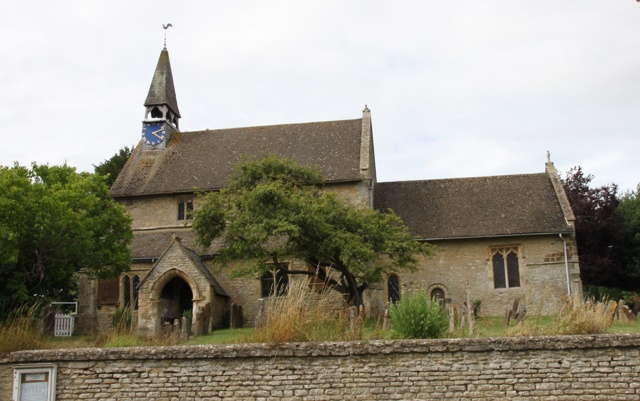


























The Church of St. Edmund and St. George, Hethe
In 1634 the churchwardens reported the church to be in bad condition, but there is no record of structural repairs. When Rawlinson visited the church in 1718 he noted the names of John Dagley and Alexander Peny (i.e. Petty), churchwardens, and the date 1708 painted on the west wall: this inscription (no longer in existence) suggests that the church was repaired then, since Rawlinson found it in good condition. In 1757 the churchwardens reported that substantial repairs were contemplated. But by 1810 the fabric was reported to be in 'a ruinous and dilapidated' condition and over £300 were spent on it. Shortly afterwards a licence was obtained to reseat the church with pews for the richer families and open seats for the poor. A drawing by J. Buckler shows the church as it was at this date, with a square bellcote surmounted by a raised roof with stone ball finial and vane. In 1833 the church was again under repair, yet in 1854 Bishop Wilberforce could say that the church was 'in most miserable order' and 'utterly too small for the population'. In 1859 the Revd. Frederick Salter undertook a thorough restoration. At a cost of £800, and to the plans of G. E. Street, a new roof was placed over the nave and chancel; a north aisle (said in 1848 by the rural dean to be needed for the poor) was added; new windows were put in; the whole church was reseated and new furniture provided. Salter made a further bequest (1881) of a painted glass window for the east end. The plain font was perhaps part of an earlier church. Rawlinson noted a fragment of armorial glass, which has now disappeared. At one time the church owned a statue of one of its patron saints, for in 1659 Wood noted that the 'effigies of St. George killing the dragon cut in stone' had been found in the churchyard. Inscriptions to Richard Evans, rector (d. 1698/9), and members of the Petty family (c. 1700) are now illegible. There are inscriptions to members of the Lamb family (18th cent.) and to John Westcar (d. 1784), George Lamb, rector (d. 1801), Richard Dutton (d. 1802), Henry Westcar of Southwark (d. 1805), William Mansfield of Bainton (d. 1846), Frederick Salter, rector (d. 1881), and four benefactors: John Mansfield (d. 1869), Thomas Mansfield (d. 1874), Mary Waddington (d. 1876), and George Mansfield (d. 1946). The church goods inventoried in 1552, including a chalice, were of little value. The present plate includes an early 17th-century chalice, inscribed '… Heath … 1716', and another silver chalice and paten, both 18th century, but given to the church in the 19th century. At the Reformation there were two bells as well as two handbells and a 'sakeringe bell'. Today there is only one bell of 1886. A former bell, dated 1755, hangs in the school. The registers date from 1678. Rawlinson noted that the earlier ones had been lost. The Vestry Book begins in 1738 and the Churchwardens' Accounts in 1803. Historical information about The Church of St. Edmund and St. George is provided by 'Parishes: Hethe', in A History of the County of Oxford: Volume 6, ed. Mary D Lobel (London, 1959), pp. 174-181. British History Online http://www.british-history.ac.uk/vch/oxon/vol6/pp174-181 [accessed 1 February 2023]. The Church of St. Edmund and St. George is a Grade II listed building. For more information about the listing see CHURCH OF ST EDMUND AND GEORGE, Hethe - 1286396 | Historic England. For more information about The Church of St. Edmund and St. George see Parishes: Hethe | British History Online (british-history.ac.uk). |

